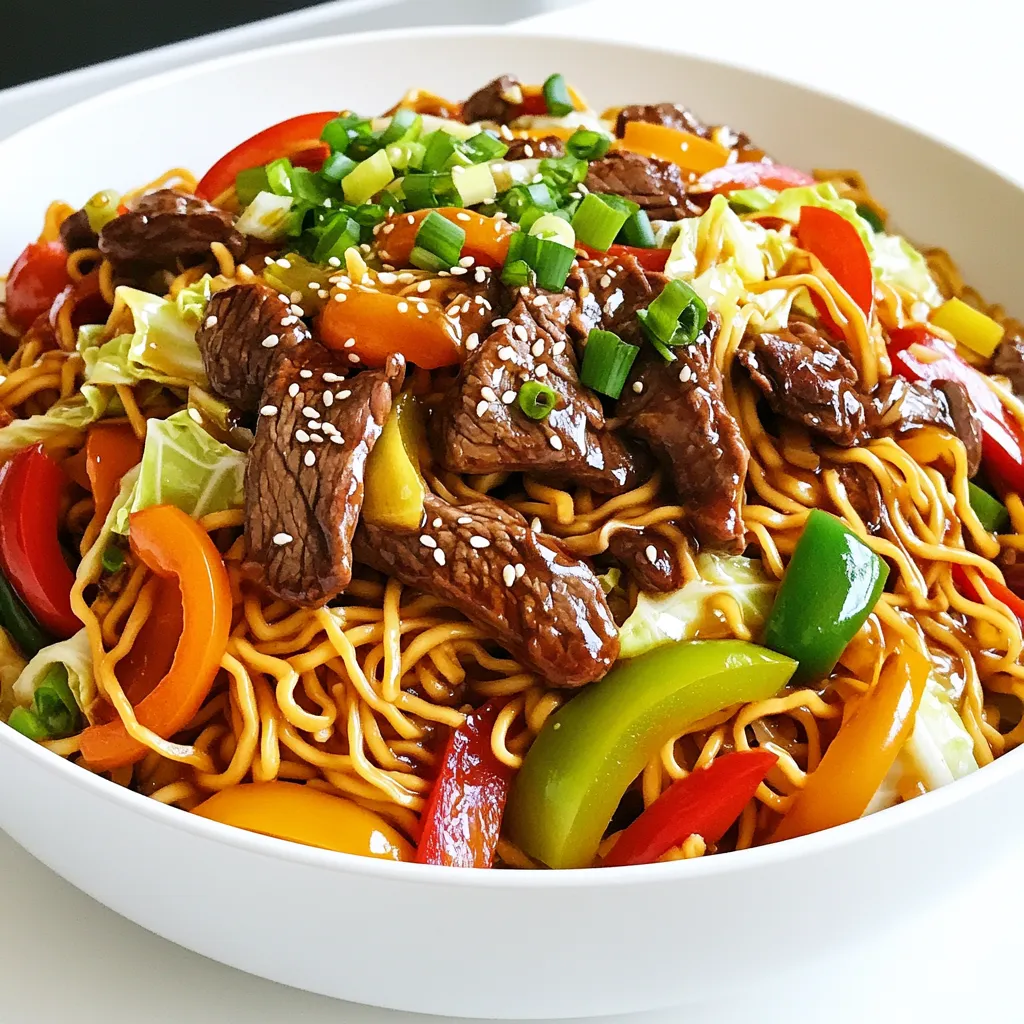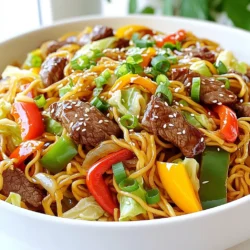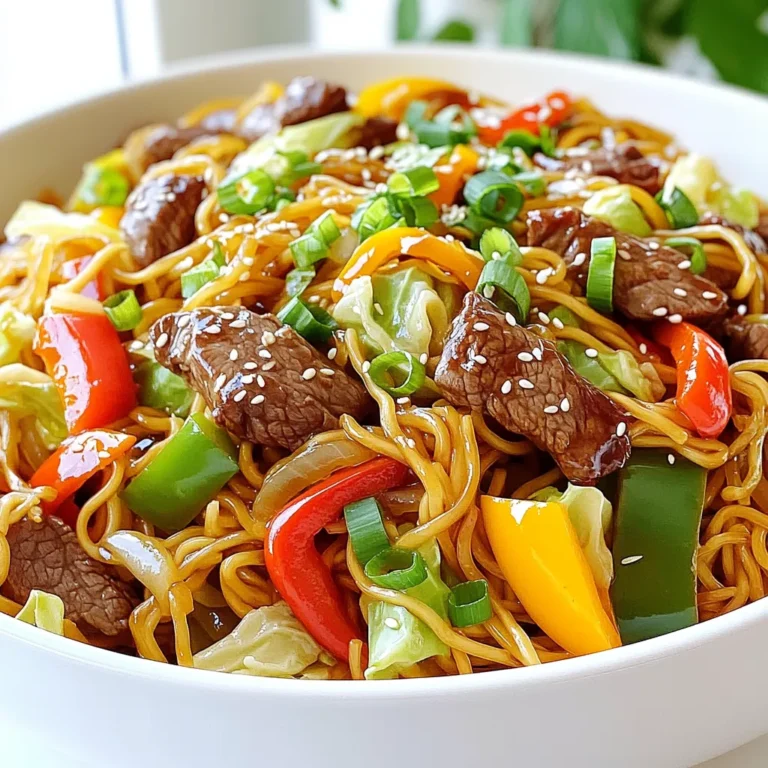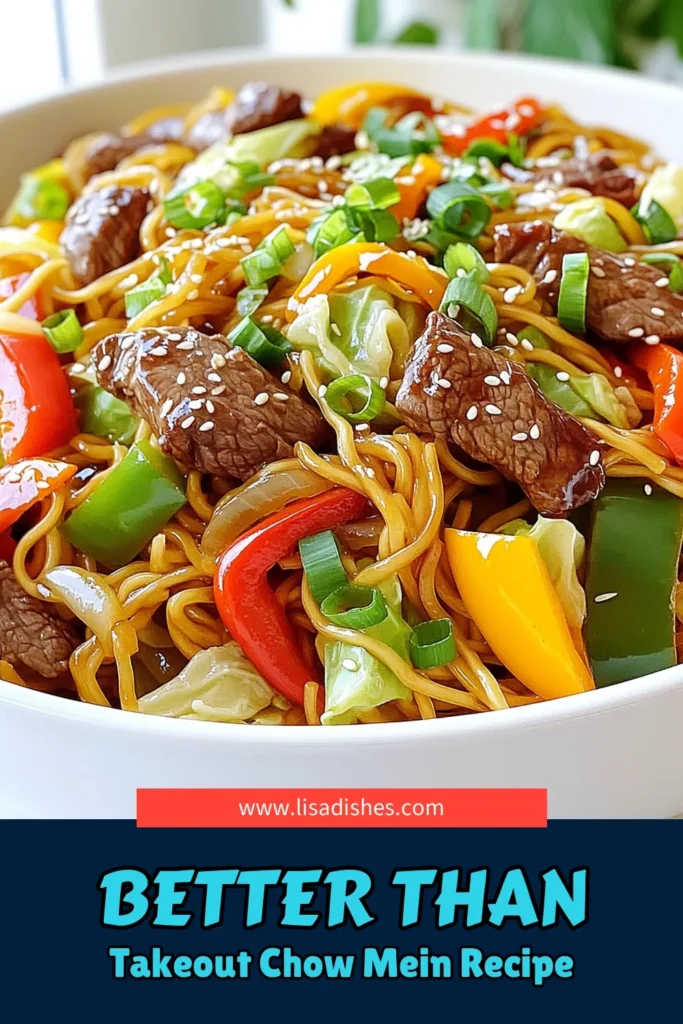Looking for a cozy meal that beats takeout? This Better Than Takeout Beef Chow Mein is your answer! Packed with tender beef, fresh veggies, and flavorful sauces, it’s sure to please. You can make this dish quickly, using simple ingredients. Whether you’re a chef or a novice, I’ll guide you step-by-step to create this comforting feast. Let’s dive into the world of homemade chow mein!
Ingredients
Main Ingredients
– 8 oz chow mein noodles
– 1 lb beef sirloin, thinly sliced
– 2 tablespoons soy sauce
– 2 tablespoons oyster sauce
– 1 tablespoon hoisin sauce
Chow mein noodles are key for this dish. They provide that perfect chewy texture. You can find them in most grocery stores. Next, beef sirloin adds great flavor. Slice it thin for quick cooking. The sauces — soy, oyster, and hoisin — give depth. Each sauce brings a unique taste that makes this dish shine.
Vegetables and Aromatics
– 1 cup bean sprouts
– 1 cup mixed bell peppers, sliced (red, yellow, green)
– 1 cup napa cabbage, shredded
Bean sprouts add crunch. They cook fast and keep a nice bite. Mixed bell peppers add color and sweetness. You can use red, yellow, or green ones. Napa cabbage is tender and delicious. It wilts down nicely but stays crisp.
Seasonings
– 1 teaspoon sesame oil
– 2 cloves garlic, minced
– 1 tablespoon ginger, minced
– Salt and pepper to taste
Sesame oil gives a nutty flavor. Use it sparingly; it’s strong. Minced garlic and ginger add warmth and zest. These aromatics are the heart of many Asian dishes. Finally, season with salt and pepper. This simple step lifts the overall taste.
Step-by-Step Instructions
Cooking the Noodles
To start, bring a large pot of water to a boil. Make sure the water is bubbling well. Next, add your chow mein noodles. Cook them according to the package instructions. This usually takes about 3 to 5 minutes. When they are just tender, drain them. Rinse with cold water to stop the cooking. Set the noodles aside for later.
Marinating the Beef
While the noodles cook, let’s marinate the beef. In a bowl, combine the sliced beef with soy sauce, sesame oil, and a pinch of salt and pepper. Mix well to coat the beef evenly. Allow it to marinate for about 15 minutes. This will help the beef absorb all the great flavors.
Preparing the Sauce
Now, let’s prepare the sauce. In a small bowl, whisk together the oyster sauce and hoisin sauce. Make sure they blend well. Set this mixture aside; it will add a delicious depth of flavor to your dish.
Sautéing Aromatics
In a large skillet or wok, heat 1 tablespoon of vegetable oil over medium-high heat. Once it’s hot, add the minced garlic and ginger. Cook them for about 30 seconds. Stir quickly to avoid burning. You want to release their fragrant aroma.
Cooking the Beef
Next, raise the heat to high. Add the marinated beef to the skillet. Cook for about 3 to 4 minutes, stirring occasionally. You want the beef to brown and be cooked through. Once done, remove the beef and set it aside.
Stir-Frying Vegetables
In the same skillet, add the remaining tablespoon of vegetable oil. Toss in the mixed bell peppers and napa cabbage. Stir-fry for 2 to 3 minutes. The veggies should be crisp-tender, adding great texture to the dish.
Combining Everything
Now, return the cooked beef to the pan. Add the cooked chow mein noodles and bean sprouts. Pour in the sauce mixture. Toss everything together for about 2 to 3 minutes. Make sure everything is heated through and well mixed.
Finishing Touches
Finally, add the chopped green onions. Toss gently to combine. Taste and adjust the seasoning with salt and pepper if needed. This dish is now ready to serve!
Tips & Tricks
Achieving Authentic Flavors
– Using High-Quality Soy Sauce
High-quality soy sauce adds rich flavor. Look for a dark variety for deeper taste. It enhances the umami notes in your dish.
– Importance of Marination
Marinating the beef is key. Let it sit for at least 15 minutes. This adds layers of flavor and makes the meat tender.
Cooking Techniques
– Using a Wok vs. Skillet
A wok is best for stir-frying. It heats quickly and cooks evenly. If you use a skillet, keep the heat high for good results.
– Maintaining Crispness in Vegetables
Cook vegetables quickly over high heat. Stir-fry for just 2-3 minutes. This keeps them crisp and colorful, adding great texture.
Presentation Suggestions
– Serving in Bowls
Serve the chow mein in large bowls. This makes it easy to enjoy and looks inviting.
– Garnishing with Green Onions and Sesame Seeds
Top with chopped green onions and sesame seeds. This adds a fresh look and extra crunch. It makes your dish pop visually and tastefully.

Variations
Protein Alternatives
You can swap beef with chicken for a lighter dish. Chicken chow mein is a great choice. Use thin slices of chicken breast, marinate them the same way, and follow the same steps.
For a vegetarian option, replace the beef with tofu. Firm tofu works best. Press it to remove water, then cut it into cubes. Marinate like you would the beef. Sauté it until golden before adding to the noodles. This adds a nice texture and flavor.
Vegetable Substitutions
Adding broccoli or snow peas can boost nutrition and flavor. Broccoli adds crunch and color. Snow peas bring a sweet taste. Stir-fry these veggies for a few minutes until bright and tender.
You can also use seasonal vegetables like zucchini or carrots. They add variety and freshness to your chow mein. Just slice them thinly and cook them quickly with the other veggies.
Sauce Adjustments
You can customize the sauce to fit your taste. If you want a sweeter dish, add more hoisin sauce. For a tangy twist, include a splash of rice vinegar.
If you like heat, sprinkle in some red pepper flakes or Sriracha. Start with a little, then taste and adjust. These tweaks make your chow mein truly your own.
Storage Info
Storing Leftovers
– Recommended Containers: Use airtight containers to store your beef chow mein. Glass or plastic containers work well. Make sure they seal tightly to keep the flavors fresh.
– Cooling and Refrigerating: Allow the dish to cool at room temperature before storing. Once cool, place the containers in the fridge. Enjoy your leftovers within three days for the best taste.
Reheating Instructions
– Best Methods (Microwave vs. Stovetop): You can reheat beef chow mein in the microwave or on the stovetop. For the microwave, use a microwave-safe dish. Heat in 1-minute intervals, stirring in between. For stovetop, warm in a skillet over medium heat, adding a splash of water to keep it moist.
– Tips to Maintain Texture: To keep the noodles from getting mushy, avoid overheating. Stir gently while reheating. This helps the flavors blend without losing that perfect texture.
Freezing Guidelines
– Suitable for Freezing?: Yes, beef chow mein can be frozen. It holds its flavor and texture well. Just make sure to use freezer-safe containers.
– Thawing Process for Reheat: When you’re ready to eat, thaw your chow mein in the fridge overnight. For a quicker method, you can use the microwave’s defrost setting. After thawing, reheat it as mentioned above.
FAQs
Can I make this recipe gluten-free?
Yes, you can make this dish gluten-free. Use gluten-free soy sauce or tamari instead of regular soy sauce. For the noodles, look for gluten-free chow mein noodles or rice noodles. These swaps will keep the flavor while making the dish safe for gluten-free diets.
How do I prevent the noodles from sticking?
To keep your noodles from sticking, follow these tips:
– Cook noodles just until tender, not overcooked.
– Rinse cooked noodles with cold water immediately after draining. This stops the cooking and removes excess starch.
– Toss the noodles with a little oil to help keep them separate.
Can I use other types of meat?
Absolutely! You can use chicken, pork, or even shrimp. Adjust cooking times based on the meat you use:
– Chicken: Cook for 4-5 minutes until no longer pink.
– Pork: Cook for about 3-4 minutes until cooked through.
– Shrimp: Cook for just 2-3 minutes until they turn pink.
What’s the best way to enhance the flavor?
To boost flavor, consider adding:
– A splash of rice vinegar for tang.
– Chili paste for heat.
– Fresh herbs like cilantro or basil for freshness.
Experiment with these to find your favorite taste.
How long does this dish last in the fridge?
Prepared chow mein lasts about 3-4 days in the fridge. Store it in an airtight container to keep it fresh. When ready to eat, just reheat it on the stovetop or in the microwave until hot.
This recipe guide for delicious beef chow mein covers all you need. We explored the key ingredients, from chow mein noodles to sauces. I shared step-by-step instructions to ensure you cook like a pro. Tips for achieving authentic flavors and variations let you customize it to your taste. Finally, I provided storage and reheating advice to keep leftovers fresh. With these insights, you can enjoy a tasty meal any day! Dive in, have fun, and savor every bite of your homemade chow mein!



